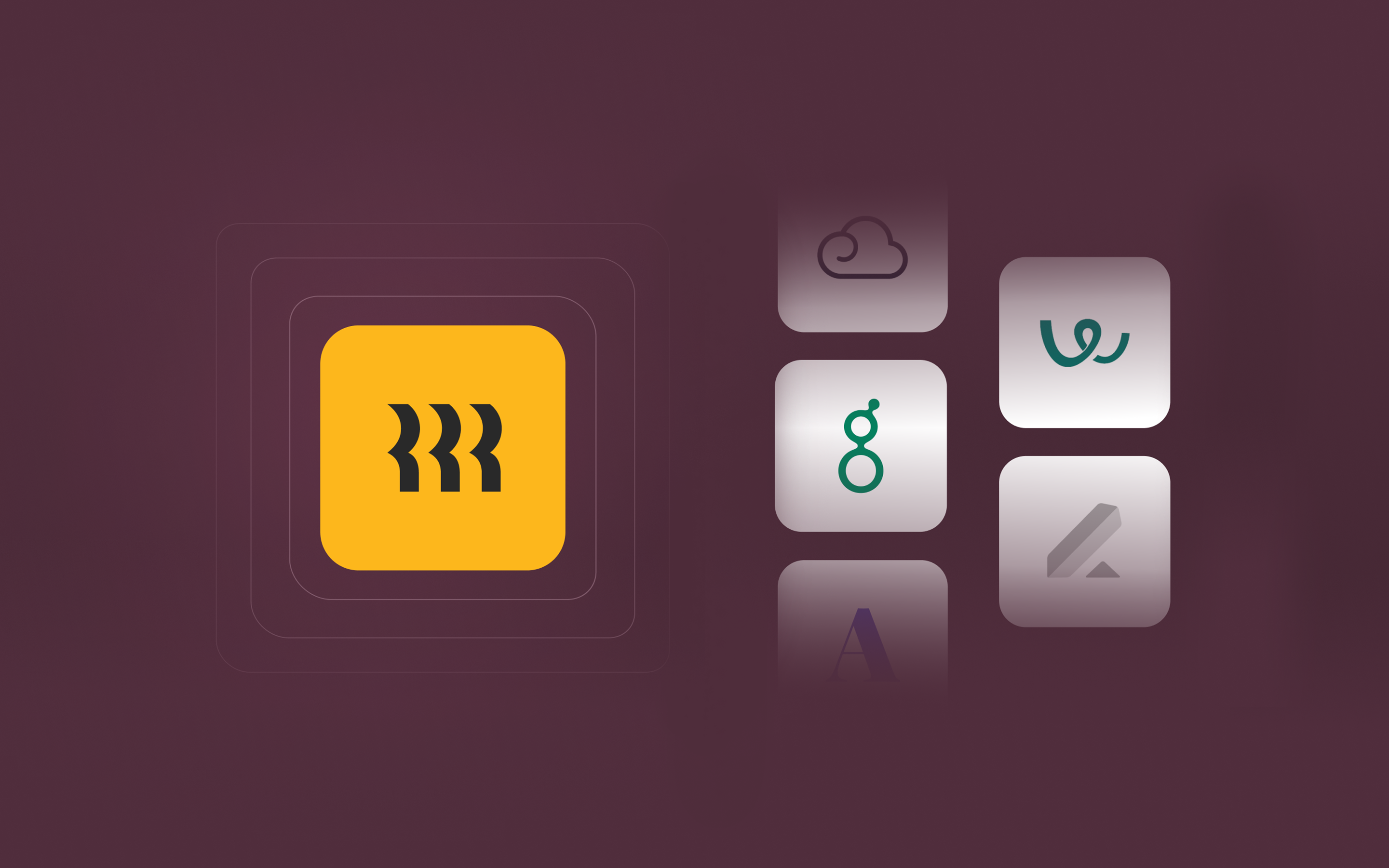The 12 Rippling competitors & alternatives for HR management

Rippling HR software has become increasingly popular among businesses of all sizes—from small businesses and mid-size organizations to scaling enterprises looking for an HR solution that addresses payroll, time tracking, recruiting, benefits administration, performance management, and other HR tasks—all in one place. With so many HR platforms out there, however, it's no surprise that HR leaders might be curious about how Rippling compares to other payroll solutions in the market. This article highlights 12 Rippling competitors and explores why many organizations choose Rippling, even when they encounter widely recognized names like Paychex, ADP, Gusto, BambooHR, Justworks, TriNet, and more.
Rippling unifies HR, IT, and finance tools in a single platform. Many businesses see it as a streamlined approach to core HR tasks—from onboarding to offboarding. However, there's no shortage of payroll solutions claiming to offer similarly unified HR and workforce management features and address unique business needs. In this post, we compare these platforms while explaining why Rippling remains a strong contender for organizations seeking customizable, all-in-one HR services.
Why businesses choose Rippling
Rippling's all-in-one workforce management platform is the top solution for HR management, payroll, and other back office tasks for many reasons. Here are just a few of the reasons why so many businesses choose Rippling:
Unified platform for HR, spend, and IT management
Rippling is the only platform that unifies HR, IT, and finance.
All of Rippling’s apps are built on top of a single source of truth for employee data. That means your employee data isn’t tied to one specific app—it’s the same across payroll software, time and attendance tracking, performance management software, and any other apps you use within the platform.
Automated onboarding and offboarding
Automatic updates are just the beginning—with Rippling's HCM software, you can automate every step of the employee lifecycle, from onboarding to offboarding.
Automated onboarding workflows handle everything from employment agreements to benefits enrollment to assigning required trainings, so your new employee can hit the ground running on day one.
And when it’s time for an employee to leave, you can automatically issue their final paycheck, suspend their access to work apps and accounts, retrieve their devices, and send them an exit survey. Rippling does it all automatically and on time, saving your team hours of manual work.
Global payroll management
Rippling's global payroll software is intuitive, easy to use, and has a 100% error-free guarantee on every pay run. It also offers automatic and accurate tax registration and filing- and a dedicated mobile app where your employees can view their W-2s and paystubs, submit expenses directly, and more. With Rippling, you can:
- Pay employees and contractors in the same platform
- Manage time and attendance natively
- Run unlimited off-cycle pay runs at no extra cost
- Set up multiple pay schedules, pay rates, and pay types in just a few clicks
- Automatically calculate prorated pay runs for new or promoted employees
- Manage all currency conversions, including payroll adjustments
- Automatically calculate overtime for every country
- Make changes after submitting payroll
Rippling global payroll offers a compelling selection of features for employers seeking an end-to-end payroll management solution capable of automating even complex tasks for a global organization.
Using natively-built payroll software, Rippling offers a seamless data pipeline that consolidates all your payroll functions on a single platform for a globally compliant pay run. Combined with Rippling’s suite of benefits management and time and attendance tools, it streamlines the entire payroll process.
Designed for a high degree of flexibility, Rippling also allows you to customize your payroll workflows, approvals, and reporting at a granular level. Because Rippling processes your payroll internally, rather than relying on local vendors and aggregating their data*, you receive prompt updates on the up-to-date internal data. Role-based approvals and reporting also protect the confidentiality of your data internally.
*Does not apply to companies outside of US
Extensive integration capabilities
Rippling has over 600 integrations with the most popular apps and tools, fitting seamlessly into whatever systems and workflows your team has in place.
What does that mean for you and your team? For starters, you have a single source of truth for up-to-the-minute employee information. It also means that your team doesn’t have to reenter information across systems when an employee gets promoted or moves to a different city to work remotely. From changing security permissions to updating PTO policies, Rippling triggers automatic updates to employee information in a single flow. It allows you to do more with less—less money, less headcount, and less time.
Top 12 Rippling alternatives and competitors
Below are 12 top Rippling competitors for HR management.
1. TriNet
TriNet may be best-known for its Professional Employer Organization (PEO) services. When working with a PEO, a business enters into a co-employment relationship with a service provider. While the business remains responsible for directing and supervising employees and all business decisions, the PEO helps take payroll, benefits, HR and compliance work off your plate.
TriNet offers PEO-focused HR software functionalities with a platform that covers payroll, benefits administration, and compliance aspects of HR. TriNet claims to deliver a more comprehensive suite of HR solutions but can require additional fees for expansions. TriNet also includes employee self service for basic tasks and has some workforce management tools.
However, the platform may lack a truly unified experience compared to a solution like Rippling. And while TriNet offers integrations with popular third-party tools like Quickbooks and Xero, they have fewer than 50 integrations overall, limiting the scope of what you can use TriNet for. Users sometimes find the interface less customizable compared to other payroll software.
TriNet vs Rippling
TriNet focuses heavily on HR outsourcing via its PEO services, whereas Rippling unifies payroll solutions and core HR tasks in a single management system (in addition to a PEO, for customers seeking more hands-off support with their HR management). For this reason, many businesses looking for flexibility and modern HRIS capabilities prefer Rippling.
2. ADP
ADP is a well-known name in payroll and HR that began as a punch-card payroll system and has expanded its offerings by acquiring more than 100 other companies. The result, however, is modules that are disjointed and deliver limited user experience and broken automations.
ADP offers multiple platforms and levels of service, like its ADP Workforce Now offering, which is an HR services and payroll solution geared toward scaling organizations. While ADP can handle large volumes of payroll data and offers additional features, from time tracking to benefits administration, some users feel that the system is not as customizable as they’d like. ADP also tends to get low customer support scores on review sites, and its reporting tools are lacking in advanced features like pivot tables, previews, and drill-downs.
ADP vs Rippling
For those comparing Rippling vs ADP, one difference is Rippling’s emphasis on core HR tasks, from onboarding to offboarding. ADP focuses heavily on payroll management; while it offers a ADP Workforce Now for organizations seeking a more all-in-one platform, it’s rated lower than Rippling in user experience and customer support according to more than 18,000 G2 reviews. Rippling also automates more admin work; when you make one change in Rippling, that change automatically updates in every part of the Rippling software. With ADP, you have to manually update over half a dozen different modules to transition or offboard an employee.
3. Workday
Workday (often recognized for its HCM capabilities) is popular among large enterprises. It encompasses payroll, time tracking, talent management, compensation management, workforce planning, and other HR features.
However, some small businesses find Workday too extensive—and potentially cost-prohibitive. While it offers employee self-service tools, it’s a complex platform that can have a steep learning curve and difficult user interface; implementation can be lengthy, and some users require specialized training to navigate Workday’s software solutions.
Workday vs Rippling
Workday gears their services toward enterprise-level HR complexities, while Rippling is an HR and payroll solution that works for a broader range of company sizes. Organizations that don’t want to deal with overwhelm may lean toward Rippling’s more straightforward approach to core HR—Rippling is flexible, offering PEO, HRIS, HCM, and more workforce management solutions, with simple ways to switch between them according to your business needs.
4. Paychex
Paychex is a longstanding provider of payroll and HR services with a variety of offerings. For example, the company’s Paychex Flex platform offers a payroll solution, benefits administration, and some HR software features primarily for small businesses.
While Paychex can generally accommodate a wide range of business sizes and needs, it’s less customizable and doesn’t offer the same breadth of employee self-service as some other platforms. And while Paychex integrates with some popular third-party platforms, including accounting apps like Quickbooks and Xero, advanced workforce management might require additional modules or platforms in your tech stack.
Paychex vs Rippling
Comparing Rippling vs Paychex, both platforms offer core HR features like payroll, benefits administration, and onboarding for new hires. However, Paychex doesn’t unify core HR functions into a single management system like Rippling does by building every system on top of a single source of truth for employee data—and these functions aren’t automated, but rather require manual changes for onboard and offboard and employee changes. And while Paychex Flex offers simple payroll services for small businesses, Rippling offers flexible and streamlined workforce management solutions that can scale with your business as it grows.
5. Gusto
Gusto has positioned itself as a payroll and HR solution that caters to small businesses. The platform includes features like benefits administration, time tracking, and employee self service, with an interface that doesn’t require much of a learning curve. Gusto also accommodates contractor payments and provides integrations with popular third-party platforms like Quickbooks and Xero.
However, Gusto’s emphasis on small businesses and ease of use mean it has limitations. For example, it may require add-ons for robust compensation management and advanced performance management. Its reporting capabilities are limited, especially compared to platforms that offer advanced people analytics, like Rippling. And some users also note that Gusto can be less flexible than they’d like when dealing with more complex HR scenarios.
Gusto vs Rippling
When comparing Gusto to Rippling, Gusto primarily emphasizes payroll management and HR tools for smaller companies, while Rippling integrates a broader set of core HR capabilities that suit companies of all sizes. Rippling is also more customizable for businesses needing multiple HR software functions in a single system. Gusto isn’t as scalable as Rippling—it doesn’t offer robust expense management, bill pay, or applicant tracking system, and growing organizations may need to switch to a different platform as their needs evolve. Further, Rippling offers robust automation and reporting features based on one source of truth—employee data—while Gusto doesn’t have custom workflows and has limited custom reporting.
6. BambooHR
BambooHR focuses on employee experience, offering different modules for HR tasks such as onboarding, time and attendance, employee benefits administration, and performance management. It offers an HRIS framework and is known for its user-friendly interface.
While BambooHR includes some payroll integrations, it’s not primarily a payroll solution—in fact, payroll isn’t included in any of its plans and must be purchased as an add-on for organizations that require payroll services. BambooHR may not handle complex multi-state payroll management as seamlessly as some competitors.
BambooHR is marketed to small businesses, but because of its modular setup, organizations may require additional software solutions or integrations for certain business needs, like compensation management or advanced reporting.
BambooHR vs Rippling
Although BambooHR delivers a straightforward approach to HR, it often lacks a fully unified offering that includes robust payroll services. BambooHR users may rely on third-party integrations for deeper payroll capabilities and other advanced HR tasks, like learning management headcount planning, and automatic localization. On the other hand, Rippling consolidates payroll with HR, IT, finance, and the rest of its unified HR platform. BambooHR does provide some reporting, limited time tracking, and other tools, but many businesses looking for a single management system might find Rippling more comprehensive and powerful.
7. Paylocity
Paylocity is an HCM that offers a range of payroll and HR features including onboarding workflows, time and attendance, talent management, benefits administration, learning management, compliance, reporting, and analytics.
Paylocity is well known in the HR world, but much of its features and functionality have come from acquiring other solutions over the years, which has resulted in disjointed modules that create limitations for users. And while Paylocity highlights its all-in-one employee management and unified HR services, the fact is that it doesn’t automate as much as other platforms, it has less advanced reporting capabilities, and it’s less simple to use.
Paylocity vs Rippling
Similar to other competitors, Paylocity can manage payroll solutions effectively, but it may not provide the same end-to-end HR software experience. For example, Paylocity’s solutions are disconnected across modules—to promote someone, you have to manually update their security group, and then update access module by module. Compared to Paylocity, Rippling automates more admin work out of the box across all of your HR modules, has higher customer satisfaction scores, offers more advanced reporting capabilities, and integrates with more third-party apps and tools.
8. Paycom
Paycom was founded in 1998, which gives it plenty of name recognition in the HR space. It offers payroll and HR solutions, including time and attendance, performance management, applicant tracking, and compensation management, and offers employee self-service tools—including Beti, a payroll tool that allows employees to run their own payroll.
One of Paycom’s biggest drawbacks is that it offers extremely limited integrations with third-party tools. Most organizations require a comprehensive tech stack, and Paycom limits your ability to connect with data outside the platform. This, in turn, limits your workflows, automations, reporting, and other features and capabilities within Paycom.
Paycom vs Rippling
Unlike Paycom, Rippling integrates fully with key third-party applications. With Rippling, you can pull data from more than 600 external apps and tools, allowing for integrations that expand the platform’s capabilities. In turn, this means Rippling offers more powerful automations that save your team time, and it has more advanced reporting capabilities.
9. Paycor
Paycor, another player in the payroll and HR space, provides an all-in-one HR solution with a user-friendly dashboard. The platform includes a range of standard employee self-service options, but integrating Paycor with certain third-party tools can be cumbersome.
While Paycor can handle various HR solutions, its legacy solution is a hodgepodge of acquisitions and white-labeled solutions, like Newton for application tracking and 7Geese for performance management, which results in a disconnected system that slows processes down, from employee experience to reporting. Paycor also lacks integrations with best of breed tools and doesn’t have the same depth of integrations as some other platforms, so organizations that need advanced functionality—like robust compensation management—might struggle to find a tool that both fits their business needs and seamlessly integrates.
Paycor vs Rippling
Both Paycor and Rippling offer payroll software and a range of HR functionalities. However, Paycor sometimes requires more configuration to manage end-to-end HR tasks in a single management system, largely due to the fact that many of its modules were added on over the years as Paycor acquired other solutions. Rippling, on the other hand, was built from the ground up to be a unified platform. Companies that want a more complete approach to HR software may prefer Rippling’s unified approach.
10. Oyster
Oyster is a remote-focused HR solution that supports global payroll and compliance. It can be beneficial for hiring internationally, but smaller organizations may not find Oyster as useful, especially if they don’t plan to scale across multiple countries.
Because Oyster places such a heavy focus on international hiring, global payroll, and compliance, it may require external integrations for certain core HR tasks, like performance management or compensation planning. Oyster reviews consistently mention poor customer support and delays.
Oyster vs Rippling
Oyster aims to simplify cross-border HR, while Rippling covers a broader spectrum of HR software features for both local and remote teams. Companies seeking a single system for payroll software and HR tasks, from onboarding new hires to finding compliant benefits around the globe, might prefer Rippling. Oyster isn’t the most robust tool for broad HR tasks, while Rippling offers comprehensive HR software that can meet a variety of business needs.
11. Deel
Deel offers HR software and payroll services with an emphasis on international and remote teams—also offering compliance support, contractor management, and localized documentation.
However, some organizations find Deel lacking in broader HR functionality, —for example, Deel doesn’t automatically sync updates across all modules, its payroll module is acquired rather than natively built, and it doesn’t offer an in-house PEO. And some users report that Deel's customer support can be slow or not available during the hours needed to resolve their issues promptly. This can be an especially tricky issue when dealing with global compliance matters.
Deel vs Rippling
Deel can be attractive to businesses expanding overseas, but Rippling also offers support for global businesses, including employer of record (EOR) services and global payroll. Rippling covers a wider range of HR features than Deel, including more advanced custom reporting, robust performance management, more than 600 third-party integrations, and more, while Deel lacks critical modules like ATS and headcount planning.
12. Justworks
Justworks is a PEO-oriented platform that handles payroll, benefits, and compliance. Similar to TriNet, Justworks focuses on simplifying HR processes for small businesses. The platform includes standard payroll service options, but some users feel it doesn’t deliver as many advanced HR capabilities as they’d like.
In addition to PEO services, it offers EORs for organizations that want to hire internationally. While it’s more advanced than many other legacy solutions, it’s still building out its HR platform and offerings beyond the PEO, so it may be too limited for some companies looking for HR software that can scale with them long-term.
Justworks vs Rippling
Justworks emphasizes PEO services, which can be helpful for certain organizations but may limit the direct control they have over their HR software. Justworks also doesn’t necessarily unify payroll, IT, and other HR services in a single management system the same way that Rippling does; for example, Justworks doesn’t offer any device management, SSO, corporate cards, or expense management software. Rippling offers PEO and EOR services for businesses that need them, but also has a true all-in-one HR platform. Justworks continues to evolve, yet Rippling typically remains more appealing for those seeking a broader HR framework.
What is the best HR and payroll software?
Managing an international workforce goes way beyond just hiring and paying—it’s headcount planning, time and attendance, learning and performance management, device ordering, app provisioning, and more. Other solutions only offer native EOR and HRIS or rely on clunky integrations for these other tools, slowing you down and requiring you to constantly reenter information between systems. Rippling can support international contractors, EOR employees, and HR and payroll for employees on your own entities—so you don’t need to replace your systems as your business scales and your needs evolve.
Rippling is the only provider that allows you to seamlessly manage your entire workforce in one unified platform.
Rippling competitors FAQs
What makes Rippling different?
Rippling stands out among its competitors for providing an array of HR tools that unify payroll and other aspects of HR management in a single platform. When you compare it to platforms like TriNet, Justworks, or Gusto, Rippling’s approach covers more ground for small businesses that require advanced control over their payroll and human resources, while it also offers comprehensive features for larger or scaling organizations.
Even with popular names like Paychex or ADP to choose from in the payroll market, Rippling offers a robust HCM platform that integrates with third-party tools like Quickbooks, Xero, and Netsuite to further enhance its capabilities.
Why is Rippling so good?
Many organizations find Rippling valuable because it merges HR tasks and payroll processing into one environment, reducing the hassle of using separate HR services.
Unlike TriNet or Justworks, which focus heavily on PEO models, Rippling can adapt to varied business needs.
Other competitors like Gusto, ADP, and Paychex may require more fragmented modules for certain HR tasks like timekeeping and benefits. Rippling’s all-in-one approach streamlines HR workflows.
Is Rippling a competitor of Workday?
Yes, Rippling does compete in the same HR and human resources technology space as Workday, but the two platforms differ in scale and target markets. While Workday caters often to large enterprises, Rippling is suited for mid-sized and large organizations with its integrated payroll and HR functionalities.
This blog is based on information available to Rippling as of January 15, 2025.
Disclaimer: Rippling and its affiliates do not provide tax, accounting, or legal advice. This material has been prepared for informational purposes only, and is not intended to provide or be relied on for tax, accounting, or legal advice. You should consult your own tax, accounting, and legal advisors before engaging in any related activities or transactions.









